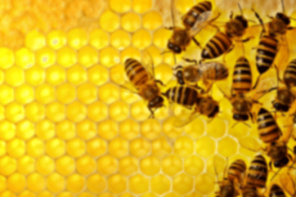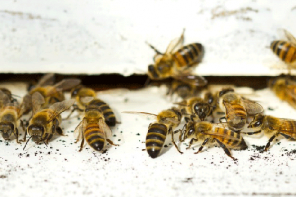I mentioned New Zealand last time, but when we returned after being there for 12 days were so rushed getting the April issue out that I didn’t get to tell much about the trip. If you’ve been to that part of the world I can’t add much about the 13 hour plane ride and losing a whole day – we left on a Saturday and arrived on Monday, missing Sunday altogether. We arrived in Auckland, on the north island and over the course of 11 days worked our way south mostly along the east coast to the southern tip of that Island at Wellington.
Our trip was arranged by beekeepers there, and we mostly stayed with beekeepers the whole time. That in itself made it an unusual adventure, for we’d be with one family for a day or three, then be handed off to another family, and so on. A couple of times we stayed in hotels, and for three nights at a camp for a three day beekeeper’s meeting.
On a map, New Zealand’s most northern tip is about the same as Buenos Aires, two thirds of the way down on that continent, and it’s most southern point is about equal to the most southern tip of South America. It’s about half way between the equator and Antarctica. So, we left the end of February – cold, dark and Winter, and arrived in Summer – warm, bright, and welcome.
We stayed that first night with Jeremy and Fiona O’Brien, commercial beekeepers who don’t make manuka honey, but run the cleanest honey house I’ve ever seen, but then, all the honey houses we saw were the cleanest we’ve ever seen. Not making manuka honey isn’t rare, but because of the value of that crop it is becoming less common as more and more beekeepers seek out the precious stuff. But people still actually want local honey, and, to be honest, manuka honey isn’t on my list of favorites as a food. Or even on my list at all actually.
So there it is. Manuka honey. The flowering shrub Leptospermum scoparium (Mānuka in Māori).
From the BEES AND TREES website, a honey packer in New Zealand –
The history of Manuka honey is that until the early 1990s, it was just one of a number of really nice honeys produced from flowering native New Zealand trees. Enter Dr. Peter Molan of the Waikato University in New Zealand, who through his research discovered a very unique and special property of manuka honey. Dr. Molan was studying the health properties of honeys which are normally attributed to a natural mild hydrogen peroxide antiseptic released when the enzyme glucose oxidase produced by the bees as a preservative in the honey comes in contact with moisture in the body.
However, this “peroxide activity” is easily destroyed by exposure to fluids, heat and sunlight. The discovery that Dr. Molan made was that Manuka honey had a different property, what he termed a “non-peroxide activity”(NPA), which was more potent and stable, opening up the possibility of a wide range of uses. The term “Unique Manuka Factor,” or UMF was coined (and trademarked) to describe this property which varied in strength as measured from different batches of Manuka honey produced in various parts of New Zealand, and from different species of manuka plants, of which there are several.
-Manuka-
Professor Thomas Henle at the Technical University of Dresden in Germany set out to isolate what it was in Manuka honey that was producing this antibacterial affect. They isolated a compound, methylglyoxal (MGO), as having a direct correlation to the UMF rating of Manuka honey. UMF is measured by observing the inhibition to growth of bacteria within honey samples. MGO can be directly measured in ppm or parts per million. UMF ratings range from 5 to 15 typically, MGO from 100-550ppm.
For labeling purposes, MGO is trademarked by Manuka Health New Zealand Ltd. UMF is registered and controlled by The Active Manuka Honey Association (AMHA). The largest member of AMHA is Comvita New Zealand Ltd.
What isn’t told here is that when manuka honey is first harvested, it has UMF ratings of five – 15, but after it sits for a year, in a drum at right about 70 degrees, that rating can increase to over 20, or more. And the more UMF there is, the more beekeepers get paid. Twenty dollars a pound for the good stuff isn’t uncommon. That’s quite an investment though. And storage is costly, and it has to be done right or the honey can change. But how much honey is in a drum, at $20/pound? That’s why regular honey beekeeper numbers are dwindling.
Manuka is a shrubby plant. Only 5’ or 6’ tall at the most, it primarily grows on land that isn’t used for anything else. Steep hill sides, tops of mountains, stream edges, rocky bluffs. New Zealand is totally volcanic in origin so there are lots of steep hills, rocky bluffs and marginal land with only an inch or so of topsoil. Empty, valueless land as far as NZ farmers were concerned. And the honey itself is like heather honey – it turns to jelly after it’s extracted – the term is thixotropic – and you need a very special machine to insert a vibrating pin into every cell to liquefy it so it can be extracted.
Before manuka, beekeepers there, like here, had locations on a farmer’s land that produced honey for mostly the whole season, would set their bees down and harvest at the end of the season. There are a few ag crops needing migratory pollination so some would move bees for that, especially to the south island for Kiwi, but migratory beekeeping doesn’t dominate the scene.
After manuka, the world changed for NZ beekeepers. First, there are now three times as many beekeepers as there were before so even finding a level place to put bees is getting difficult. Beeyards near manuka stands have become fought-over locations, with farmers charging an arm and a leg and a percent of the crop to put bees on their land. And commercial operations are flooding manuka areas, setting bees wherever they can find a spot, anywhere near manuka. This, of course reduces the crop for everybody, but at $20/lb, that’s acceptable to big outfits, though little operations can’t sustain themselves on that alone.
Hive theft has gained in popularity too, as has simple honey theft off the hives. Why steal bees when all you want is the honey? Only beekeepers steal hives.
And then there’s Australia. And the New Zealand copyright on the name “Manuka Honey”. Australia has manuka, too. Some say they had it first and it was transported to NZ, and of course now the courts are involved. I’m not sure where that will end up, but it won’t be good for anybody I’d guess.
This has been compared to the California gold rush. Lots and lots and even more players are getting involved in keeping bees and harvesting what they hope is manuka honey. Players are hostile, and some dangerous, with equipment being destroyed or stolen, locations being squeezed by unfair competition…the list goes on. So who is making it in this gold rush? Well, those good folks selling beginner kits to new beekeepers and more equipment to existing beekeepers, security cameras to beekeepers with remote beeyards, farmers with manuka on their land, storage security units, special extracting equipment dealers and of course honey packers who buy this stuff. In the California rush, mostly the sellers of picks and shovels and food were the winners. Like this.
You can buy manuka honey today in the US. I got some +5 UMF (very weak) at Costco for just over $30 for a kilo, (2.2 lbs) and a 500 gram (22 oz) bottle of 10+ UMF for just over $40.
I’ve heard it’ll cure anything but a broken heart.
•
If you haven’t yet, take a look at the two honey reports this month. Even if you only have a single colony in the back yard the information on these reports will have an effect on what you can, can’t and might do this season. We know that many backyard beekeepers never sell a jar of honey. It’s simply a welcome benefit to having bees back there. We harvest it, bottle it and give it away to friends, family and neighbors. Maybe we sell a few to co-workers or friends who know the value of a pound jar of this stuff and insist they pay.
And many of us do sell but only at local venues – the farm market on Saturday, a nature center event once a summer, or a craft fair before the holidays. For those the wholesale price of honey in a barrel from India seems far, far away having no influence on your little business, but you would be wrong.
When honey prices are low, and they have been for several years now due to very, very inexpensive import prices, commercial beekeepers have to evaluate the costs of what they do. Are the costs of labor, equipment and debt worth the income from whatever honey nature allows them to make in a season? If they lose money on even a good honey crop, the probability of them not spending more money next season to lose more money again begins to increase. To the point of looking for other sources of income.
When the big guys quit buying bottles, extractors, uncappers and the like – when demand for those items declines – the supply dwindles and prices begin to increase. It’s Econ 101 all over again.
If you’re big enough to have product in a store somewhere, the people buying your honey look at a wholesale price of less than a buck from their store brand, and your price of over $3 and can make the same decision. They both sell, but they make a lot more on the imports than on yours. It’s Math 101, all over again. So know the game you’re playing in. The rules, the penalties and returns.
There are other consequences to the information on the report that have nothing to do with price however. And that’s the bigger picture of where beekeepers are making money anymore. Pollination is now the star attraction, and honey is slowly sliding off the table. When you can’t compete in a price war, but you are in the bee business, how do you stay there? Well, two things have happened that give an answer.
One of them is almonds. That chart from ERS explains it well, and almonds is the name of the game. They make up 82% of the fees paid to pollinators and 50% of all the acres pollinated for revenue. More importantly, pollination in general makes up 41% of all beekeeper revenue while honey this year made up 40%. It’s not much of a difference, but it’s the first time ever pollination has exceeded honey for money.
It will interesting to see what happens next year if China puts a hefty tariff or embargo on almonds this year. It’s always something.
•
It’s just about May when you get this but still early April when I’m writing it, and maple buds are just beginning to break. They’re late. And the typical first lawn mowing is on the 15th, five days from now. No Way. And as of today we have two, count them, only two daffodils blooming. We planted over 100 last year, and have about that many from before. Two. You can hear the bees grumbling all the way from the back yard. Happy Spring. Keep your smoker lit, you’ll need it to keep warm.











